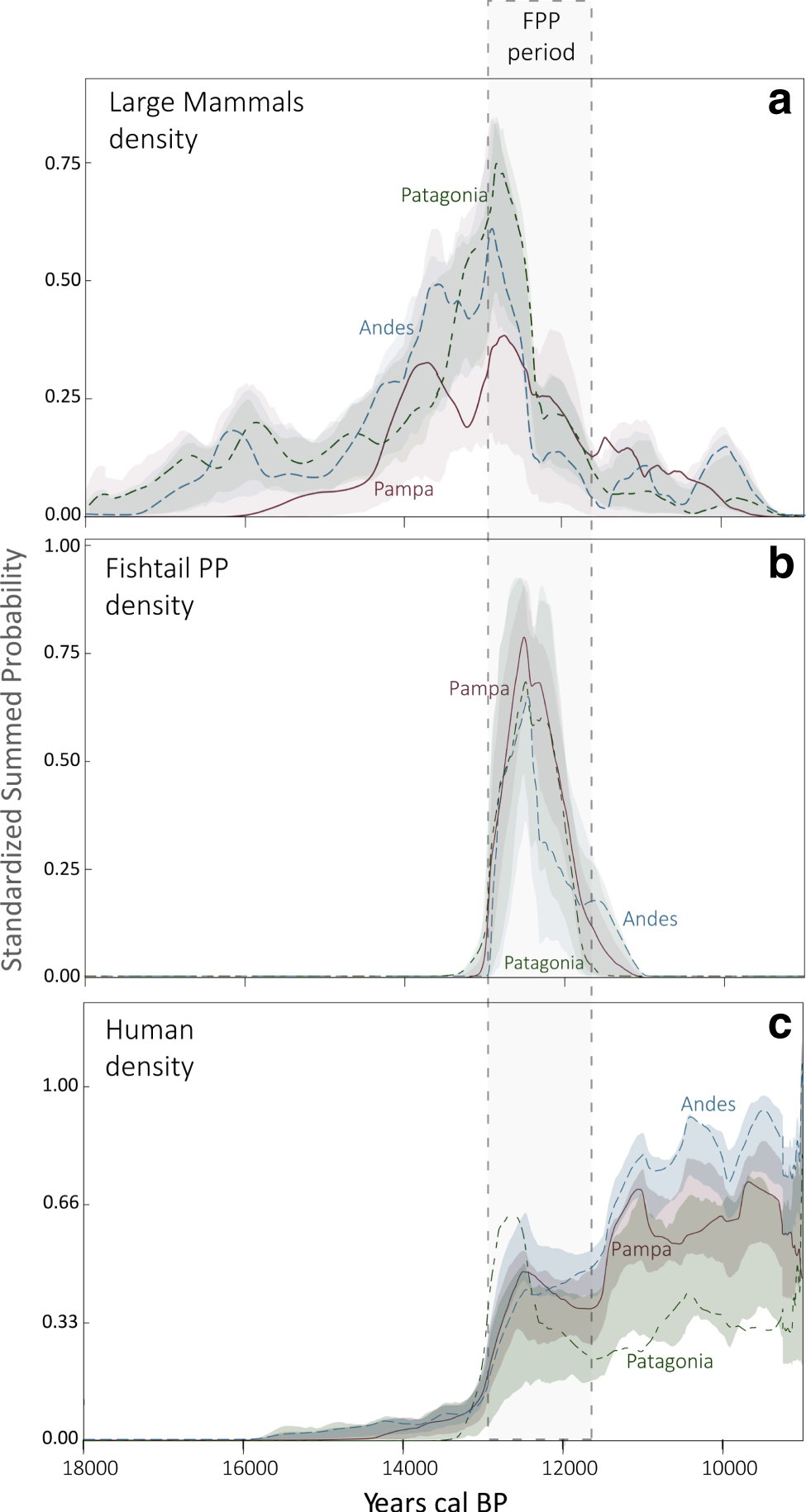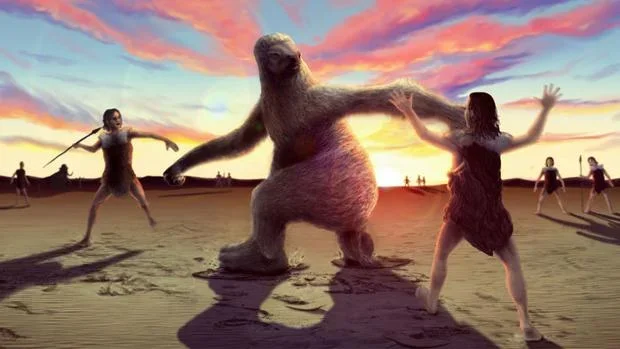Did humans cause the extinction of the giant ground sloths?
"We believe that human beings are mainly responsible for the extinction of megafauna in South America," said Luciano Prates and Ivan Perez, CONICET researchers at the Faculty of Natural Sciences and Museum of the National University of La Plata, Argentina, and authors of a scientific study on the matter, which is published in the journal Nature communications.
Based on a vast amount of data collected via fossil and archaeological records ranging across the entire subcontinent, their work associates the hunting activity of the first groups of people with the demographic decline, and subsequent disappearance, of all large mammal species, occurring at the end of the Pleistocene Epoch (also known as the Ice Age), between 13 and 11 thousand years ago.
A recreation of humans hunting giant sloths / Illustration: Alex Macclelland, Bournemouth University
The fish tails
This study contradicts the widely accepted hypothesis in South American archeology: that large animals disappeared as a result of environmental changes. It was thought that the increasing temperatures and changes to vegetation resulting from the previous ice age (about 18 thousand years ago) was the catalyst which led to a mass extinction.
Instead, the new research focuses on where temporal and geographical evidence coincides, specifically where megafauna and 'fish tail'spearheads overlap. This very specific type of spearhead is similar to the 'Clovis' spearhead, which existed only in North America and is closely associated with hunting mammoths.
Preserved ‘Clovis’ points, like this one, were the first clear evidence of human activity in North America. These spearheads were used by the Clovis people to hunt large animals, and it’s existence coincides with the extinction of mammoths, giant sloths, and giant bison in North America./ Photo: pleistoscenery
“In both cases, they are large, broad tools with a very sophisticated technology,” Prates describes, “Their existence is very short-lived: they only appear between 13 and 11 thousand years ago and they are not found any earlier on.” Adding to this evidence, scientists observed that the demographic curve of human beings began to decrease over the same period megafauna entered the last stage of extinction.
More evidence for an old hypothesis
This new evidence emerged after comparing 51 temporal records of the 'Fishtail' tip with 269 fossils of ten megafauna species – including the American horse and the Megatherium or giant ground sloth– all dated using radiocarbon techniques, which determines the age of carbon-containing materials.
“What we found first is that populations of megafauna kept increasing until at one point - 12,900 years ago - they began to decline sharply. This coincides exactly with the moment of appearance of the fishtail tips, so we suppose that when humans obtained this new technology they began to hunt these mammals, and hence led to the decline of these populations,” explains Perez.

The temporal change in the density of large mammals (a), Fishtail projectile points (b), and all archeological sites (c) described using SCPD curves. Different regions are indicated in shading colors: Andes (light blues), Pampa (light red), Patagonia (light green). X-axis represents Calibrated years BP and Y-axis the standardized summed probability. / Image: Luciano Prates e Ivan Perez
"This situation lasts for 2,000 years and ends with the simultaneous disappearance of the animals and the spearheads, which shows us that they were intimately linked," adds Prates. In this scenario, the drop in the human demographic curve is a result the overhunting of the fauna - human populations began to reduce due to the disappearance of one of their main subsistence resources.
Methodology
The published research also includes a geographic analysis comprising of 156 spatial records of 'fishtail' tips and another 204 spearheads which correspond with specimens of megafauna. These specimens came from 1660 archaeological sites between 7-15 thousand years old throughout South America.
The results also support the authors' hypothesis that the majority of the megafauna were found in the same places as the weapons. "This means that the people who hunted with this technology were located in the regions where these animals lived, which were mainly the open steppes of the pampas of Uruguay, southern Brazil and Argentina, and Patagonia,” says Prates.
This figure shows the density of megafauna in South America (left), and the density of ‘Fishtail’ points (right) / Image: Researchers courtesy
“Using all this information as a base, a product of combined paleontological and archaeological evidence, our work postulates that human beings were primarily responsible for the extinction of the megafauna."
"However, early humans did not compulsively attack all the species present, as suggested by the North American paleontologist Paul Martin 40 years ago," says Perez, "We suspect that people dedicated themselves to hunting only a few species, however this caused such a deep imbalance within the ecosystem that eventually, given the added climatic changes, triggered a general collapse of the entire community of large mammals."
Prates L., Perez I., Late Pleistocene South American megafaunal extinctions associated with rise of Fishtail points and human population. Nature communications. DOI: https://doi.org/10.1038/s41467-021-22506-4
Original article in Spanish: https://laplata.conicet.gov.ar/extincion-de-la-megafauna-los-seres-humanos-tendrian-mucha-mas-responsabilidad-de-lo-que-hasta-ahora-se-creia/





